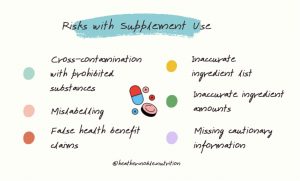By: Heather Noble, RD
Iron is absolutely essential for athletic performance. Iron is important for endurance athletes in particular because of the strenuous physical demands placed on their aerobic system and muscles. Low iron levels can lead to exhaustion, weakened immune system, poor recovery, decreased performance, and can take up to 3-6 months to normalize iron stores! Iron deficiency anemia is very prevalent among both elite and recreational athletes, especially females, and in many different sports.
What is Iron?
Iron is an essential mineral found in the body and is important for many physiological functions, some of which include:
- Key component of hemoglobin
- Red blood cell production
- Involved in enzymes that release the energy for exercise
- Maintaining a strong immune system and central nervous system function
- DNA synthesis
Hemoglobin is a complex protein found in red blood cells with four subunits, each containing an iron molecule. Its primary function is to deliver oxygen to the body’s tissues through aerobic metabolism. Myoglobin is the oxygen binding protein found in muscle tissue and delivers oxygen to the muscles. Iron is transported throughout the body by transferrin, stored in the body as ferritin, and released when needed to make new blood cells in the bone marrow.
Red blood cells have a natural lifespan of 120 days. In many athletes however, the turnover rate is increased significantly because of damage to the RBCs from strenuous training. However, this is advantageous as newer cells are more efficient in transporting oxygen. Your iron status and daily dietary iron intake will affect the quality and the oxygen carrying capacity of each new red blood cell. Therefore, it is so important you meet your iron needs every day.

Figure 1: Heme and nonheme are the two types of iron. Our bodies only absorb a very small fraction of the iron we actually ingest; however, heme iron is absorbed better than nonheme iron. Heme iron is found in animal products only and nonheme iron is found in some plant-based and animal products.
Iron Rich Foods:
- Meat: beef, pork, lamb, veal
- Poultry: turkey, chicken, duck
- Leafy greens: broccoli, kale, collard greens, spinach
- Legumes: beans, peas, black beans, lentils
- Seafood: salmon, haddock, tuna, anchovies, sardines, oysters
- Iron-fortified cereal, grains, rice and pasta
- Dried fruit, nuts
How much iron do we need?
Iron requirements are much are higher during periods of growth; this includes pregnancy, lactation, menstruation, early childhood, adolescence, and athletes. Athletes may need up to 50% more iron than non-exercising individuals as they are constantly undergoing changes of growth and repair- however, this estimate remains controversial. Iron requirements are 1.8 times higher for vegetarians & vegans because of the lower bioavailability of nonheme iron. Iron is entirely regulated by iron absorption through the small intestine as our bodies are unable to actively remove iron from the body.
| Age (years) | Male Iron needs/day (mg) | Female Iron needs/day (mg) |
| 9-13 | 8 | 8 |
| 14-18 | 11 | 15 |
| 19-30 | 8 | 18 |
| 31-50 | 8 | 18 |
| 51-70 | 8 | 8 |
| >70 | 8 | 8 |
Foods that Inhibit Iron Absorption:
Avoid these when consuming iron-rich foods for better absorption. These do not need to be avoided at all times.
- Coffee and tea. These contain polyphenols which decrease absorption.
- Calcium: Examples of food high in calcium include milk, edamame, sesame seeds, bok choy, broccoli, tofu, kale, fortified orange juice.
- Dark green vegetables. These contain oxalic acid which decreases absorption.
- Bran cereals. These contain phytates which bind to iron and other minerals, which makes them unavailable for absorption.
- Iron is competitively absorbed with other minerals (calcium, zinc and magnesium) so consuming a large amount of one or more of these will lower the absorption rate.
Foods that Increase Iron Absorption:
- Pair iron-rich foods with foods high in Vitamin C. Ex. Add orange slices, tomatoes, and/or peppers to a spinach salad. Other foods high in Vitamin C include oranges, orange juice, grapefruit, kiwi, strawberries, cantaloupe, brussels sprouts, broccoli, peppers, cabbage, potatoes and tomatoes.
- Blanching (put in boiling water for 5-10 seconds) dark green vegetables will help remove the oxalate in order to increase absorption.
- Eating non-heme iron sources with heme sources also increases the absorption.
- Absorption of iron increases when iron stores are low which helps protect us from becoming deficient.
Iron Deficiency Anemia:
Iron deficiency anemia is the most common type of anemia, however is very preventable in most cases. Iron deficiency anemia can develop over three main stages. The first stage is “iron depletion” where ferritin levels (iron stores) start depleting first, the second is “iron deficiency without anemia” where we have low ferritin and low transferrin (transporter protein) saturation, and the third is “iron deficiency anemia” where hemoglobin, red cell size and serum iron are also reduced.
Iron deficiency anemia can have severe consequences as an athlete. It decreases the oxygen delivery to the tissues, and can lead to muscle weakness and fatigue, compromised immunity and impaired body temperature. Impaired physical performance has been seen in early stages of iron deficiency. It can take up to 3 to 6 months for iron stores to return to normal levels due to their long lifespan.
There are also many different forms of anemia which can be caused by other nutrient deficiencies such as folate and Vitamin B12 (pernicious anemia). Talk to your health care professional for more information.

Figure 2: Here are some of many symptoms and consequences of iron deficiency. Please speak to you doctor or a medical professional if you are experiencing any of these symptoms.
What are some risk factors for low iron?
- Blood loss: gastrointestinal bleeding (this is very significant in intense endurance events), women are at greater risk because of menstruation, individuals frequently donating blood, injuries where large amounts of blood have been lost
- High training loads: athletes with very high training volumes will have increased iron needs because of the body’s adaptive response to increase red blood cells and muscle myoglobin. Iron is also lost through “foot strike hemolysis” which is the red blood cells breaking from the impact of running
- Inadequate energy intake: individuals not consuming enough food and calories to support their energy expenditure and training demands, those on a vegetarian or vegan diet that is unbalanced, or those with a low intake of iron rich foods in general
- Inadequate absorption: individuals experiencing various forms of malabsorption (Celiac Disease, Crohn’s disease, Ulcerative Colitis, Peptic Ulcer Disease)
- Other contributors: small amounts of iron are also lost through consuming anti- inflammatory pain relievers (Ex. Advil, Motrin, Aspirin etc.)
A few reminders:
- Eat your iron! Consume an iron-rich diet and pair non-heme iron sources with Vitamin C before relying on supplements.
- Ask your doctor before taking high-doses of iron.
- Athletes with normal iron levels do not need to take iron supplements and can actually lead to iron overload. Iron toxicity will not occur from food only- this can only occur through supplementation.
- Excess iron can have negative health and performance effects. Please remember that “more does not mean better” when it comes to supplements!


